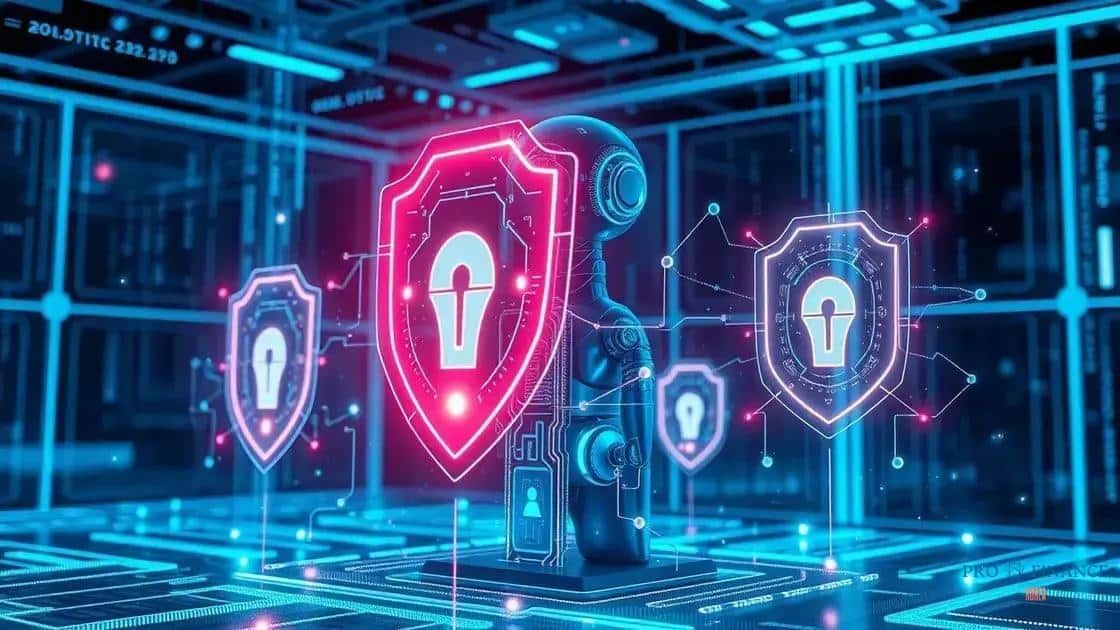The role of AI in cybersecurity and fraud prevention

The role of AI in cybersecurity is to enhance threat detection, automate responses, and manage complex data, making systems more secure against evolving attacks.
The role of AI in cybersecurity and fraud prevention is becoming increasingly vital in today’s digital landscape. As cyber threats evolve, AI technologies offer promising solutions to keep our data safe. What if you could enhance your security measures with the help of AI?
Understanding AI in cybersecurity
Understanding AI in cybersecurity is crucial as threats continue to evolve. As companies face increasing risks, integrating artificial intelligence enhances their defenses.
AI systems analyze vast amounts of data, identifying patterns that may indicate a breach. This proactive approach not only detects threats but also responds to them in real-time.
How AI Works in Cybersecurity
AI technologies leverage algorithms and machine learning to improve security measures. These systems continuously learn from historical data, adapting to new threats.
- Predictive analytics helps forecast potential attacks.
- Automated responses mitigate damage quickly.
- Behavior analysis identifies suspicious activities.
Moreover, AI tools can enhance user authentication processes. By employing biometric data or behavioral analytics, these systems create a more robust security framework.
Benefits of AI in Security
Incorporating AI brings several advantages:
- Increased efficiency in threat detection.
- Reduced response times to potential breaches.
- Lower operational costs through automation.
AI also assists in managing extensive networks, offering insights that would be impossible for humans alone. As organizations integrate AI into their cybersecurity strategies, they bolster their defenses against evolving threats.
Key benefits of AI for fraud prevention
The key benefits of AI for fraud prevention are transforming how businesses protect their assets. With its ability to analyze large datasets quickly, artificial intelligence enhances security measures significantly.
One of the most notable benefits is real-time detection of fraudulent activities. AI systems can monitor transactions instantaneously, identifying unusual patterns that may indicate fraud. This swift action helps prevent significant losses before they occur.
Enhanced Accuracy and Efficiency
AI also improves the accuracy of fraud detection. Traditional methods often rely on rules and historical data, which can be limiting. In contrast, AI utilizes machine learning to continuously adapt and refine its algorithms.
- Reduces false positives, ensuring legitimate transactions are not blocked.
- Identifies complex fraud schemes that may evade standard methods.
- Provides deeper insights into customer behavior.
This ability to learn from each transaction makes AI a critical asset in the fight against fraud and abuse.
Cost-Effectiveness
Incorporating AI into fraud prevention can also be cost-effective. Automating the detection process cuts down on labor costs while allowing staff to focus on high-priority tasks.
- Reduces the need for extensive manual reviews.
- Minimizes the financial burden caused by fraud incidents.
- Improves overall operational efficiency.
Ultimately, by utilizing AI, businesses not only safeguard their resources but also enhance their reputation by providing a secure environment for customers.
Common AI tools in cybersecurity
Common AI tools in cybersecurity are essential for modern security practices. These tools help organizations detect and respond to threats more effectively. By using artificial intelligence, businesses can identify potential risks before they escalate into serious issues.
One popular tool is intrusion detection systems (IDS). These systems monitor network traffic for suspicious activity, alerting security teams to potential breaches. They analyze data patterns and can adapt over time, improving their accuracy and response.
Machine Learning Algorithms
Another critical tool is machine learning algorithms. These tools enable security systems to learn from past incidents. By studying data from previous attacks, they can identify new threats more efficiently.
- Helps in detecting anomalies in user behavior.
- Enhances the ability to forecast potential vulnerabilities.
- Automates responses to common threats.
These algorithms work continuously, providing real-time protection against evolving threats.
Security Information and Event Management (SIEM)
SIEM systems collect and analyze security data from across the organization. They provide a centralized view of security activities, helping teams respond to incidents quickly.
- Aggregates logs from various sources for comprehensive analysis.
- Uses analytics to detect potential threats and breaches.
- Facilitates compliance with security regulations.
Furthermore, many SIEM solutions now integrate AI capabilities, enhancing their effectiveness in threat detection and response.
Utilizing these common AI tools in cybersecurity allows organizations to stay ahead of potential threats. By harnessing the power of AI, businesses can create a robust defense strategy that adapts to new challenges.
Challenges of implementing AI in security

The challenges of implementing AI in security can be significant. While artificial intelligence offers many advantages, organizations face hurdles that must be addressed for successful integration. Understanding these challenges is vital for effective deployment.
One major challenge is the complexity of data. AI systems require vast amounts of data to learn effectively. Without high-quality, relevant data, their performance can suffer. This often means organizations must invest in data collection and cleaning processes, which can be time-consuming and costly.
Integration with Existing Systems
Another challenge involves integrating AI tools with existing security systems. Organizations may have legacy systems that are not compatible with new AI solutions. This integration process can lead to disruptions and require significant resources.
- Cost of upgrading or replacing old systems.
- Training staff to use new technologies effectively.
- Potential downtime during the integration phase.
Moreover, ensuring that these systems work together seamlessly is essential for maintaining security coverage.
Addressing Skills Gaps
A further challenge is the skills gap in the workforce. AI technologies are still relatively new, and many security teams may lack the expertise needed to implement and manage these tools effectively.
- Identifying and hiring qualified personnel can be difficult.
- Ongoing training is necessary to keep skills updated.
- High demand for skilled workers can lead to increased salaries.
Organizations must invest in training programs to bridge this gap and empower their teams.
Despite these challenges, the potential benefits of AI in security often outweigh the difficulties. With careful planning and investment, organizations can overcome obstacles and leverage AI to strengthen their security posture.
Future trends of AI in cybersecurity
The future trends of AI in cybersecurity promise to reshape how organizations protect their systems. As cyber threats become more sophisticated, artificial intelligence is expected to play an even greater role in enhancing security measures.
One key trend is the rise of predictive analytics. AI will analyze historical data to forecast potential threats before they happen. This proactive approach enables organizations to take preventive measures, significantly reducing the risk of breaches.
Automated Threat Response
Another emerging trend is the development of automated threat response systems. These systems can not only detect threats but also initiate immediate responses without human intervention. This capability streamlines security protocols, making them more efficient.
- Reduces response time to incidents.
- Minimizes damage during a security breach.
- Allows security teams to focus on strategic planning.
Such advancements are crucial as organizations face an increasing number of attacks.
Integration with IoT Devices
Furthermore, AI will increasingly integrate with Internet of Things (IoT) devices. These interconnected devices will generate vast amounts of data, and AI can help analyze this data for potential vulnerabilities.
- Enhances real-time monitoring of devices.
- Identifies unusual patterns in device behavior.
- Offers dynamic security measures tailored to device types.
This integration ensures that both traditional and IoT systems are safeguarded against evolving threats.
As AI technology continues to advance, we can expect even more innovative solutions that will strengthen cybersecurity frameworks. The combination of enhanced analytics, automation, and IoT integration will lead to a safer digital landscape.
FAQ – Frequently Asked Questions about AI in Cybersecurity
How does AI improve threat detection?
AI enhances threat detection by analyzing vast amounts of data quickly, identifying patterns, and recognizing anomalies that may indicate a security breach.
What are the benefits of automated threat response?
Automated threat response systems can react to security incidents immediately, reducing response times and minimizing potential damage without human intervention.
What challenges do organizations face when implementing AI in security?
Organizations may struggle with integrating AI tools, dealing with data complexity, and addressing the skills gap in their workforce.
What future trends can we expect from AI in cybersecurity?
We can expect trends like predictive analytics, increased automation in responses, and greater integration of AI with IoT devices, enhancing overall security measures.






